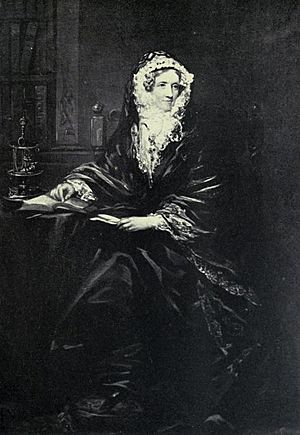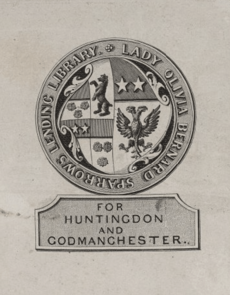Lady Olivia Sparrow facts for kids
Lady Olivia Sparrow (born Acheson) (1776–1863) was an important Anglo-Irish woman who owned land and helped many people. She became a widow in 1805. Lady Olivia was a strong believer in the evangelical movement, which focused on personal faith and good deeds. She was involved in many groups that worked for good causes. She was also a close friend of famous people like Hannah More and William Wilberforce, who fought to end slavery.
Lady Olivia played a key role in bringing together Arthur Wellesley and Kitty Pakenham. They later became the Duke and Duchess of Wellington, a very famous couple.
Contents
Early Life and Beliefs
Lady Olivia was the oldest daughter of Arthur Acheson, 1st Earl of Gosford. Her mother was Millicent Pole.
In 1801, a friend named Marcus Beresford sent a letter from Olivia to Arthur Wellesley in India. This letter also mentioned Kitty Pakenham, who was Olivia's good friend. This letter is seen as the first step towards Arthur and Kitty's marriage in 1806.
Lady Olivia and her father supported a minister named Ezekiel Blomfield. After her husband died in 1805 and her father died in 1807, Lady Olivia's religious beliefs grew even stronger. She became a very dedicated evangelical.
In 1808, the artist Cornelius Varley visited Ireland because Lady Olivia invited him. Between 1808 and 1814, another artist, Gaspare Gabrielli, painted beautiful frescos at Tandragee Castle, which Lady Olivia owned.
In 1814, Lady Olivia traveled to the Lake District in England. She was with friends who also supported William Wilberforce. They visited famous writers like Robert Southey and William Wordsworth. Wordsworth's brother noted that Lady Olivia was very passionate about her beliefs. On their way back, they met the poet James Montgomery.
Lady Olivia's teenage son, Robert, was often sick. In 1817, she built a special house for him in Villafranca, France. She hoped the warmer climate would help him get better. She visited this house until 1824.
The famous writer Sir Walter Scott was very interested in the story of a 17th-century outlaw named Count Redmond O'Hanlon. Scott wrote to Lady Olivia because her land at Tandragee was where O'Hanlon used to live. Scott wanted to write an adventure novel about O'Hanlon. Lady Olivia tried to find information for him, but there wasn't enough history to write the book.
Life at Brampton Park
Around 1819, William Wilberforce visited Lady Olivia at her home, Brampton Park, in Huntingdonshire. Lady Olivia was very involved in local politics. In 1820, she supported a candidate for the Huntingdonshire election.
In 1822, Lady Olivia's daughter married Lord Mandeville. This marriage brought together the Sparrow family's properties and Lady Olivia's lands at Tandragee with the Montagu family's estate at Kimbolton. Her daughter and son-in-law lived at Brampton Park.
In 1825, Lady Olivia hired the architect John Buonarotti Papworth to improve Brampton Park. She also supported three local churches in Huntingdonshire. Many important religious figures visited her at Brampton Park, including Joseph John Gurney and César Malan.
Lord Mandeville, Lady Olivia's son-in-law, shared her strong religious views. He gave important talks about faith. Lady Olivia also supported the building of special cottages at Brampton around 1837.
Supporting Schools
Lady Olivia also worked with John Buonarotti Papworth on schools in the Brampton, Huntingdonshire area. These schools sometimes had the initials OBS, which stood for Olivia Bernard Sparrow.
In 1835, she hired Ridley Haim Herschell to manage her schools, starting with one in Leigh, Essex. He later moved to Brampton in 1836. Lady Olivia started a girls' school in a building that later became Brampton Grange.
At Leigh, Lady Olivia faced challenges with her schools. The local church leader, Robert Eden, did not agree with her approach to education. He was a High Churchman who believed the church should control schools. Lady Olivia decided to run her schools independently. This disagreement led to a public discussion in a newspaper called The Record, which supported Lady Olivia's efforts.
Important Friendships and Family
Around 1813, Lady Olivia became very good friends with Hannah More, a famous writer and philanthropist. They wrote many letters to each other. After Hannah More died in 1833, Lady Olivia shared her letters to help write Hannah's biography.
Lady Olivia also shared her strong religious beliefs with her family. Her sister-in-law, Mary, found comfort in Lady Olivia's faith. Lady Olivia introduced Mary to Francis Cunningham, a vicar, which helped Mary connect with other religious leaders.
Around 1826, Lady Olivia hosted a dinner in London where she introduced Joseph Wolff, a missionary, to Lady Georgiana Walpole. They later married.
Lady Olivia's sister, Lady Mary, married Lord William Bentinck, who became the Governor-General of India in 1828. Before they left, Lady Olivia held meetings at her home to discuss missionary work. They read books about India and discussed how to help people there.
In 1848, Lady Olivia chose the Rev. Edward Bird to be the vicar of Wyton. Edward Bird's daughter, Isabella Bird, later became a famous traveler. Isabella became good friends with Lady Olivia. She often visited Lady Olivia at Brampton Park in the mid-1850s.
Lady Olivia's Family
In 1797, Olivia married Robert Bernard Sparrow. He was an army officer. Robert Sparrow died on August 29, 1805, in the West Indies. He was buried in Tobago. A monument was built for him in a church in Suffolk, England.
Their son, Robert Acheson Bernard St. John Sparrow, died in Nice, France, in 1818, when he was only 19 years old.
Their daughter, Millicent, was also involved in her mother's charity work. In 1822, Millicent married Lord Mandeville. She later became the Duchess of Manchester in 1843.
Millicent died in 1848. After her death, there was a legal disagreement between Lady Olivia and her son-in-law, the Duke of Manchester. Lady Olivia sought legal advice. She owned a lot of land and had a good income from her properties.




